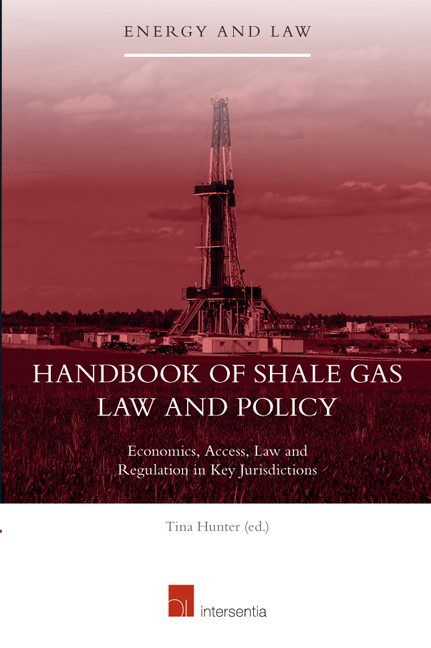Book contents
- Frontmatter
- Preface
- Contents
- List of Tables and Figures
- List of Authors
- Part I Overview and Introduction to Shale Gas Activities
- Part II Shale Gas Economics and Energy Security
- Part III Access to Shale Gas Resources
- Part IV Shale Gas Law and Regulation
- Regulating Hydraulic Fracturing
- Regulating Well Integrity
- The Environmental Challenges of Shale Gas Extraction
- An Overview of Shale Gas Law and Policy
- Shale Gas Law and Regulation in the United Kingdom
- Shale Gas Law and Regulation in North America
- Shale Gas Law and Policy in Australia
- Part V The Future of Shale Gas in the United Kingdom
- Index
Shale Gas Law and Regulation in the United Kingdom
from Part IV - Shale Gas Law and Regulation
Published online by Cambridge University Press: 21 September 2018
- Frontmatter
- Preface
- Contents
- List of Tables and Figures
- List of Authors
- Part I Overview and Introduction to Shale Gas Activities
- Part II Shale Gas Economics and Energy Security
- Part III Access to Shale Gas Resources
- Part IV Shale Gas Law and Regulation
- Regulating Hydraulic Fracturing
- Regulating Well Integrity
- The Environmental Challenges of Shale Gas Extraction
- An Overview of Shale Gas Law and Policy
- Shale Gas Law and Regulation in the United Kingdom
- Shale Gas Law and Regulation in North America
- Shale Gas Law and Policy in Australia
- Part V The Future of Shale Gas in the United Kingdom
- Index
Summary
INTRODUCTION
The development of petroleum resources in the UK is not a new phenomenon. Off shore exploration began in the mid-1960s, but the exploitation of conventional hydrocarbons onshore dates back to the end of the First World War, and oil shales were exploited in Scotland for over a century from the middle of the 19th century. Current daily production stands at around 20,000–25,000 barrels of oil equivalent (boe). Despite the popular perception that the development of shale gas will involve the deployment of technologies new to the UK, industry and regulators have already had experience of HF (hydraulic facturing) and directional drilling (DD) in the extraction of conventional petroleum activities. Of the more than 2,000 wells drilled onshore, approximately 200 of those have undergone HF. Indeed, the combination of HF and DD enabled the development in 1979 of the Wytch Farm Field in Dorset, Europe's largest onshore producing field. However, exploration for gas from shale reservoirs (shale gas) has been minimal to date, in part due to public concerns about the technologies involved and the adequacy of the current regulatory framework to prevent environmental harm, including groundwater contamination.
Shale gas, and its associated activity of HF was first brought to the attention of the UK public in the spring of 2011, when Cuadrilla resources undertook HF of an exploration well at Preese Hall, near Blackpool. This HF triggered two mild seismic events in April and May, and resulted in the UK Government imposing a temporary moratorium on shale gas activities while a review of the risks related to HF was undertaken. The Preese Hall incident and its link to HF triggered what has now become a tsunami of community concern and activism, thrusting the activity of HF and the development of shale gas into the spotlight.
In response to the Preese Hall incident a study was undertaken by the Royal Society and the Royal Academy of Engineering (RS & RAE), focusing on the major risks associated with HF as a method of extracting shale gas in the UK. The outcomes of the study were made available in the publication Shale Gas Extraction in the UK: A Review of Hydraulic Fracturing (the RS & RAE Review).
- Type
- Chapter
- Information
- Handbook of Shale Gas Law and PolicyEconomics, Access, Law and Regulation in Key Jurisdictions, pp. 281 - 304Publisher: IntersentiaPrint publication year: 2016

